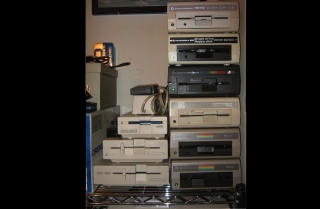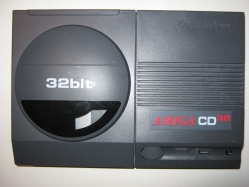SIMM 64 MB PS/2 EDO for Blizzard 1230 MK IV
Autopsy:
I have upgraded the memory to 64mb, so now I’ve got an Amiga 1200 with 64mb Fast RAM and 2mb Chip RAM ;-D
Autopsy:
I have upgraded the memory to 64mb, so now I’ve got an Amiga 1200 with 64mb Fast RAM and 2mb Chip RAM ;-D
Autopsy:
from Wikipedia:
The Final Cartridge III was a popular extension cartridge which was created for the Commodore 64 and Commodore 128, produced by Riska B.V. Home & Personal Computers. It offered a fast loader, increasing the speeds of the disk drive, and a freezer, allowing the program execution to be stopped to be resumed later.
Final Cartridge III Manual here
Thanks to Krille McKrill for his donation.
source: wikipedia rr.c64.org
Autopsy:
Description:
from Amiga Resource:
source: amiga.resource.cx
Autopsy:
Description:
from Amiga Resource:
source: amiga.resource.cx
Autopsy:
The IDE-fix adapter doubles the internal IDE port of your A1200. At the same time it’s an adapter from the rather uncommon 2.5 inch standard to the less expensive 3.5 inch standard connections. The first of the two IDE outputs is available as 3.5 inch and 2.5 inch connector, to you can use existing cables.
The IDE-fix adapter is buffered and terminated. That means that your Amiga is shielded from noise that is caused by long cables, so it continues working reliably without crashing.
IDE-fix 97 Key features:
source: vesalia.de
Autopsy:
During the 80s, it was common use to build computers in a way that they can output their picture on a TV set. This was done in order to reduce the overall system cost for the user. TV sets work with lower frequencies compared to today’s monitors, therefore the picture flickers. A flickerfixer (aka de-interlacer) converts the signal in a way that a modern VGA monitor or TFT-display can be used. The name flickerfixer was mainly created because the problem of a flickering picture is solved. Individual Computers already had a very successful product called Indivision in 2002. It was connected to the monitor output of the computer, but it has been sold out since 2006. Indivision AGA‘s most notable features are:
source: vesalia.de forum
Autopsy:
from Project Homepage:
The 1541-III is a PIC microcontroller controlling an FAT16 MMC/SD card with .D64 files. It is connected to a Commodore computer via the standard IEC-bus (the serial bus normally used to connect diskdrives and printers).
The main goal of the circuit is to behave like a 1541 disk drive (therefore the name 1541-III). The MMC/SD card contains D64-files (or normal .PRG files).
source: Project 1541 III
Autopsy:
Description:
from Amiga Resource:
source: amiga.resource.cx
Autopsy:
Description:
from Amiga Resource:
source: amiga.resource.cx

Autopsy:
My Commodore Floppy drive collection is completed!
Description:
from Wikipedia:
The Commodore 1570 was a 5¼” floppy disk drive for the Commodore 128 home/personal computer. It was a single-sided, 170KB version of the double-sided Commodore 1571, released as a stopgap measure when Commodore International was unable to provide large enough quantities of 1571s due to a shortage of double-sided drive mechanisms.
Like the 1571, it could read and write both GCR and MFM disk formats. The 1570 utilized a 1571 logic board in a cream-colored Commodore 1541 case with a drive mechanism similar to the 1541 except that it was equipped with track zero detection.
source: Wikipedia
Autopsy:
Vector A2000i with installed 4mb of ram.
Description:
from Amiga Resource:
source: amiga.resource.cx

Autopsy:
Description:
from Wikipedia:
The Amiga CD32, styled “CD32“, was the first 32-bit CD-ROM based video game console released in western Europe and Canada. It was first announced at the Science Museum in London, United Kingdom on 16 July 1993, and was released in September of the same year.
The CD32 is based on Commodore’s Advanced Graphics Architecture chipset, and is of similar specification to the Amiga 1200 computer. Using 3rd-party devices, it is possible to upgrade the CD32 with keyboard, floppy drive, hard drive and mouse, turning it into a personal computer.
source: Wikipedia
autopsy:
Description:
from Amiga Hardware:
The A2090 is a full length Zorro II card which contains a SCSI controller and an ST506 (IBM XT MFM) controller. The card does not support autobooting, however there were solutions released which allowed the card to boot, such as the Commodore Autoboot Card or the Combitec AutoBoot Card (A2090b). This card is known by serveral names, but it is the same hardware.
For example the SCSI controller supplied with the A2500 is simply this card. It was also known as the A2092 which was simply this card packaged as a “Hard Disk Upgrade Kit”, including a 40MB hard drive for the A2000. To confuse matters further this “Hard Disk Upgrade Kit” was sometimes referred to as the A2094. The A2090a is simply this card, prefitted with auto-booting ROMS. The card uses the Zilog 80B processor. If you intend to use this card in Zorro III machines, then all drivers and buffers must be loaded into Chip RAM and not Fast RAM.
Bootable versions of this card uses its own custom booting method and ironically does not use the Commodore RDB standard which most hard drive controllers use. In order to prep and format the drive, a special prepping utility is required.You cannot have partitions larger than 256MB without a patch. In order to autoboot, you need at least Kickstart 1.3.
source: amiga-hardware.com
Recent Comments